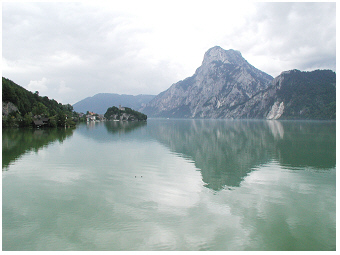Über den
Traunsee:
Der tiefste und zugleich zweitgrößte See in Österreich weist eine
verhältnismäßig kurze Verweilzeit des Wassers im Seebecken auf
geographische lage in den österreichischen alpen
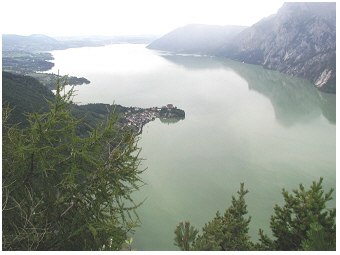 Traunsee, 2002:
Traunsee, 2002:
Blick vom Berg Sonnstein hinunter auf den nördlichen Teil des
Seebeckens. Die tiefste Stelle von 191 Metern liegt etwas weiter
nördlich von der Traunkirchner Halbinsel, die am Westufer,
d.h. links zu sehen ist. Die tiefste Stelle befindet sich etwa
in der
Mitte von dem West-Ost-Transekt in der Höhe des Berges Traunstein,
dessen Fuß an dem felsigen Ostufer, rechts im Bild, zu sehen ist. Traunsee, 2002:
Traunsee, 2002:
Die Almhütte auf dem Berg Sonnstein („Sonnsteinhütte“)
mit Blick auf
den See ist ein beliebter Ort, um eine Rast einzulegen und
eine
Jausen essen. Es werden einfache traditionelle Gerichte hier auf 923
Metern über dem Meeresspiegel zubereitet.
Eingefügtes Detail rechts unten: Eine typische Jaus’n kann ein kaltes
oder heißes „Würstel“ mit „Gebäck“ (Scheibe Brot,
Brötchen, Semmel) bzw. einer warmen „Suppn“ (Foto), ein belegtes
Schinken-, Kas-(Käse) bzw.
Aufstrichbrot oder eine „Mehlspeis“ (Kuchen) bzw.
„Tortn“ sein. Die Hütte ist nur zu Fuß auf einem Bergweg erreichbar.
Der Traunsee (47°52’16.9''N, 13°47’34.89''E) befindet sich 422 m über dem Meeresspiegel im Salzkammergut in Österreich. Dieser alpine See liegt nur 20 km vom Attersee S, 35 km vom Mondsee S und 40 km vom Hallstättersee S entfernt. Der See hat eine längliche Form und erstreckt sich vom Süden (Dorf Ebensee) nach dem Norden (Stadt Gmunden). Mit einer maximalen Tiefe von 191 m ist der Traunsee der tiefste See in Österreich. Die Seefläche beträgt 25,6 km2 und das Seewasservolumen 2302 x 106 m3. Verglichen mit dem Mondsee, ist der Traunsee 2,7 mal tiefer und hat ein 4,5 mal größeres Wasservolumen. Ungeachtet dieser Seengröße vom Traunsee beträgt die theoretische Verweilzeit des Wassers, d.h. die Zeit, die theoretisch benötigt wird, um hydrologisch den gesamten Wasserkörper auszutauschen, nur ein Jahr (Tabelle 1 in Dokulil et al. 2006 R). Die Verweilzeit dieses tiefen großen Sees ist damit 7 Monate kürzer als bei dem flacheren und kleineren Mondsee. Der Grund für die kurze Verweilzeit des Wassers im riesigen Wasserbecken vom Traunsees ist die große Durchflussmenge vom Fluss Traun[1], der rasant durch den See fließt (siehe Details im nächsten Textkapitel). Durch diesen Fluss ist der salzhaltige Hallstättersee (halbes Jahr theoretische Verweilzeit) mit dem Traunsee verbunden, womit beide Seen demselben Einzugsgebiet angehören. Der Traunsee ist hydrologisch weniger mit Attersee und Mondsee verbunden, auch wenn diese beiden Seen in einer näheren Nachbarschaft zum Traunsee liegen als der Hallstättersee.
So wie sich das Jahr in vier Jahreszeiten in der gemäßigten Klimazone untergliedert und sich diese saisonale Abfolge in den vier jahreszeitlichen Aspekten der Vegetation beispielweise widerspiegelt, durchlaufen auch die Seen saisonale Zyklen. Die saisonale Sukzession in einem See ist eng an die Wassertemperatur gebunden. Sie bedingt z.B. direkt die saisonale Abfolge der thermischen Schichtungsverhältnisse. Aber auch andere Charakteristika, wie zum Beispiel die Jahresdynamik der Nährstoffkonzentrationen, die Verhältnisse der Nährstoffe untereinander, die Artenabfolge in der Phytoplankton- bzw. Zooplanktongemeinschaft usw. weisen Muster einer saisonalen Abfolge auf. In zumindest groben Zügen entwickeln sich die physikalisch-chemischen und biologischen Jahreszyklen in den Seen gleichartig, sofern die Seen in der gleichen Klimazone liegen, eine vergleichbare Seebeckenmorphologie und Hydrologie besitzen (d.h. es flache oder tiefe bzw. stark oder weniger stark durchflossene Seenbecken sind) und auch einen vergleichbaren Nährstoffgehalt besitzen (d.h. einen nährstoffarmen oder nährstoffreichen Wasserkörper zum Beispiel haben). Vergleichbare Seenökosysteme, die geografisch sehr nahe liegen und vielleicht sogar innerhalb eines Einzugsgebietes liegen und somit direkt miteinander verbunden sind, weisen oftmals einen sehr engen zeitlichen Gleichklang oder saisonalen Takt in ihrer Jahresentwicklung auf. Diese synchrone Abfolge zwischen verschiedenen Ökosystemen wird in der Seenkunde als zeitliche Kohärenz bezeichnet. Solche Kohärenz wird zum Beispiel paarweise zwischen Seen verglichen, wie hier zwischen den See-Paaren der drei großen Seen im Traun Einzugsgebiet, d.h. dem Traunsee (T), dem Hallstätter See S (H) und dem Wolfgangsee (W). Von den drei See-Paaren T-H, T-W und H-W ist die Kohärenz zwischen dem Seepaar Traunsee-Hallstätter See (T-H) am höchsten (Abb.2 in Dokulil & Teubner 2002 R, Tabelle 3 in Dokulil & Teubner 2002 R). Für dieses Seepaar zeigt sich eine höhere Kohärenz sowohl bezüglich der Jahresdynamik der Wassertemperatur, der verschiedenen Nährstoffe als auch der Planktonentwicklung, wenn man diese mit der Kohärenz dieser einzelnen Aspekte der anderen beiden Seenpaare, T-W und H-W, vergleicht (siehe auch zeitliche Kohärenz und Klimaeinfluß auf Seen bei der Beschreibung zum Mondsee S auf dieser Website).
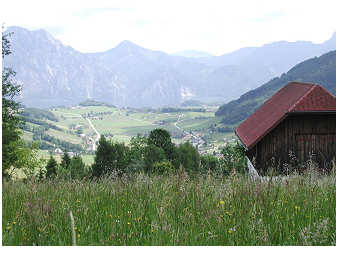 Traunsee, 2002:
Traunsee, 2002:
Blick vom Westufer über den See (Altmünster Bucht) und den Berg
Traunstein. Im Vordergrund vom Foto ist eine blühende Alpenwiese zu
sehen.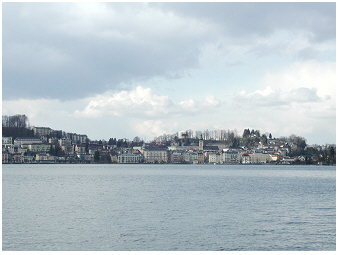 Traunsee, 2001:
Traunsee, 2001:
Die größte Stadt am See ist Gmunden. Sie liegt am Nordende vom See, wo
zugleich der Ausfluss vom See gelegen ist.
 Traunsee, 2001:
Traunsee, 2001:
Blick vom Ufer auf die Südbucht und die schwimmende Rohrbrücke (rechts
im Bild) vom Sodawerk in Ebensee. Die Sodaproduktion wurde hier 2005
eingestellt.Der Traunsee
ist ein beliebtes Ausflugs- und Urlaubsziel in den österreichischen
Alpen.
Wiesen und felsige
Berge umranden weite Strecken das Ufer des Sees. Die einzige größere
Stadt am Traunsee ist
Gmunden.
Diese Stadt liegt im Norden vom See, an
dem Abfluss in den Fluss Traun. Gmunden hat somit seit jeher kaum
den großen Bergsee beeinträchtigt, weder durch einen Eintrag von
Nährstoffen noch durch eine andere Verschmutzung. Neben Gmunden grenzen
nur kleine Dörfer an die urban umgestalteten Ufer neben weiten
naturbelassenen Uferbereichen an. Der nährstoffarme Gewässer-Status vom
Traunsee steht im Einklang mit einer nachhaltigen Landwirtschaft in
dieser Bergregion, dem Einzugsgebiet des Sees.
Trotz der ursprünglich-nährstoffarmen Gewässerqualität gilt der
Traunsee NICHT als Referenz-See für die Gruppe der großen,
tiefen
alpinen Seen im Salzkammergut. Andere natürliche
Besonderheiten dieses Sees, wie die ungewöhnlich kurze Verweilzeit des
Wassers in diesem großen Seebecken, die für einen alpinen See relativ
hohe Wassertrübung sowie der relativ hohe Salzgehalt, stellen diesen
See als
individuelles Ökosystem gegenüber anderen alpinen Seen heraus. Darüber
hinaus sprechen auch die potenziellen Auswirkungen der Einleitung von
mineralisch-salzhaltigen
Abwässern im Zuge der Sodaproduktion gegen eine
Einstufung als natürliches Referenzgewässer (die Geschichte der
Salzgewinnung und deren Bedeutung für das Seenökosystem wird im näheren
Detail für den
benachbarten Hallstätter
See
S
auf dieser Webseite beschrieben).
All diese besonderen Aspekte sind nicht unerheblich, sodass
wir bei dem Traunsee nicht von einem typischen Alpensee
sprechen könnten. Die limnologischen Besonderheiten dieses
Sees werden im Detail in den nachfolgenden zwei Abschnitten beschrieben.
the river traun: a turbid plume flows through longitudinal the lake
River Traun↑[1] is the main tributary of Traunsee and enters the lake on the south shore, the shallow bay areas close to the village Ebensee. The river passes the lake along the longitudinal extension from south to north and flows out at the town Gmunden. The water of the river mainly distributes small particles of inorganic material from the alpine catchment and riverbed into the lake which colours the lake azure blue slightly milky green. The turbidity of the water in Traunsee is hence highest in the south, at the inflow of River Traun (3D-lake-plots of turbidity in Fig.6 in Dokulil & Teubner, 2002 R). The lake becomes less turbid, the closer the water to the north end of the lake flows. Other lake parameters as e.g. the pH value, the chloride concentration and the conductivity values follow in principle this variation pattern of the longitudinal extension from the southern river inlet to the northern river outlet (Figs.4&7 in Dokulil & Teubner, 2002 R; see also the last paragraph of this page about the lake site impacted by industrial tailings by salt mining studied from December 1997 to October 1998). The nutrient ratio of nitrogen to phosphorus (N:P) at the water surface layer, however, revealed a different pattern than simply following the south-north transect. The ratio of N:P at water surface from 0 to 20 m seems to represent rather the depth heterogeneity of the large water basin comprising shallow bays and deep areas with steep slopes near the deepest site of 191 m (see N:P in Fig.7 in Dokulil & Teubner, 2002 R).
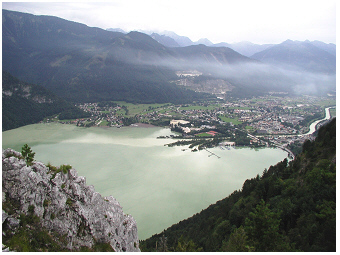 Traunsee und der Fluss
Traun, 2002:
Traunsee und der Fluss
Traun, 2002:
Blick vom Berg Sonnstein auf die südliche Bucht und das Dorf Ebensee.
Der wichtigste Zufluss ist die Traun und ist im Tal auf der rechten
Seite im Foto zu sehen.
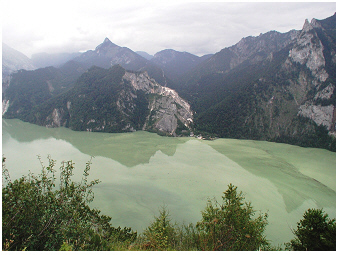 Traunsee, 2002:
Traunsee, 2002:
Blick vom Sonnstein Berg auf den See. Das Foto ist im Sommer
aufgenommen. Zu dieser Jahreszeit entlädt der Gebirgsfluss Traun große
Mengen mineralischer Schwebestoffe (mineralische Partikel) in den See.
Diese Fluss-„Wolke“ färbt den See azurblau bis milchig grün. In diesem
extrem nährstoffarmen See ist daher die hellgrüne Wasserfarbe NICHT
durch Massenentwicklungen von Algen bedingt.
More than one-third of annual precipitation usually occurs in summer in the Traunsee district. July is the rainiest month contributing about 12 % to annual precipitation. After periods of high precipitation, the river plume of inorganic suspended solid material can be readily identified on the surface of the lake by measuring the turbidity along the vertical profile (see cloudy water in the both photos above). The water of Traun River, exemplified for the year 1999, was in August about 13 °C and hence stratified in the lake at a surface depth layer with corresponding water temperature (see depth profile T5 and T9 in Fig.5 in Dokulil & Teubner, 2002 R). The river plume horizon in the lake was then seen by a sharply stratifying turbid horizon in the top 6.5 to 20 m along the 140 m depth profile nearby the south bay. Even further away from the Traun-inflow, at the deepest site (called site Viechtau, 191 m depth), the stratifying plume showed up as an enhanced inorganic turbidity in the surface layer. The River Traun hence affects Lake Traunsee twofold. The turbid river plume lowers water transparency in the nutrient-poor, i.e. oligotrophic, freshwater system. Further, the elevated river discharges contribute mainly to a rapid renewal of water in the huge freshwater basin.
the plankton in lake traunsee:
a deep lake without a chlorophyll maximum in the deep layer
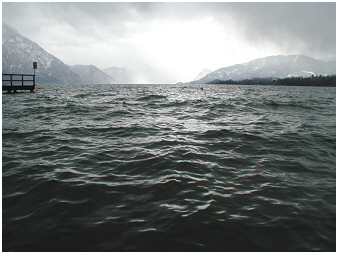 Traunsee, 2001:
Traunsee, 2001:
Blick vom Ufer weit über den großflächigen nördlichen Teil des Sees. In
der Ferne ist die Halbinsel Traunkirchen am Westufer (Foto rechts) und
der Berg Traunstein am Ostufer (Foto links) zu sehen.
The lake is characterized by low nutrient availability for
growth of algae and photosynthetic bacteria drifting at the surface of
the water basin. In particular, the phosphorus
concentration is low. Total phosphorus, measured for
depth-integrated samples from 0-20 m, has an annual average of 7.5 µg
per L (0.24 µmol L-1) for the
deepest site and
8.7 µg per L (0.28 µmol L-1)
for the south
‘Ebensee’ bay (December 1997 to October 1998, Fig.2
in
Teubner 2003 R).
This nutrient-poor,
i.e.
oligotrophic state corresponds to a low biomass development of algae
and cyanobacteria in Traunsee. A rough estimator of this biomass is the
photosynthetic pigment chlorophyll-a as described in greater detail for
lake Mondsee
S.
The annual average of chlorophyll-a
concentration measured for depth-integrated samples
(0-20m) was at the deepest site of Traunsee 1.36 µg per L only. The
main chlorophyll development was found mid May-June with concentrations
of
2.37 µg per L associated with annual peaks
of photosynthetic rates (Fig.8
in
Dokulil & Teubner 2003 R, Fig.1
in
Teubner & Dokulil 2002 R).
In view of the poor nutrient availability, Traunsee
is
close to ultra-oligotrophic Attersee
S
(Fig.8
in
Teubner 2003 R).
The photosynthetic
microorganisms
drifting in the water, i.e. the phytoplankton
organisms in Traunsee belong to diverse algal groups
(diatoms, cryptophytes, dinoflagellates, chrysophytes, chlorophytes)
and cyanobacteria as is common in other lakes. As exemplified by the
year 1998, the diatoms
contributed with up to 93 % most to the phytoplankton in spring
in Traunsee (page 1587
in
Teubner 2003 R).
Seasonality of phytoplankton in 1998 can be mainly
described by diatom biomass changes. As diatoms specifically utilize
the nutrient element silicon, the top water layer of predominant
photosynthetic activity (0-20 m) coincided with relative high
silicon
exhaustion in comparison to the other two main nutrients as phosphorus
and nitrogen. The main diatom species in Traunsee were Aulacoseira
ambigua, Asterionella formosa, Tabellaria flocculosa, Fragilaria
crotonensis, F. ulna and various
unicellular centric diatoms. Cryptophytes contributed up to 55% of
total phytoplankton in late summer and autumn. Other algal groups as
dinoflagellates, chrysophytes, chlorophytes and cyanobacteria were of
minor importance and reached not more than 26% of the total biovolume
during the annual cycle.
In terms of the size
structure of
phytoplankton, the small organisms are much more abundant
in the plankton community of alpine lakes than those of large
biovolume. It could be shown, that in Lake Traunsee the small algae,
which refer here to the algal size fraction that has passed a filter
with the mesh-size of 10 µm, contributed far more than the half to
total chlorophyll (63% were measured for Traunsee, the same was valid
for Mondsee, page 316
in
Teubner et al. 2001 R).
Measuring photosynthesis
in Lake Traunsee, the small size fraction of phytoplankton (0-10µm)
indicated a relative high light utilization efficiency and relative
high portions of light-harvesting to photo-protective pigments than the
size fraction of larger cells (larger than 10µm, Figs.4&8,
Table 2
in
Teubner et al. 2001 R).
This allometric rule, that
cell size
determines photosynthetic properties, was not only
measured for phytoplankton in Traunsee, but also other for other alpine
lakes as Mondsee and Lucerne (Teubner
et al. 2001 R).
 Traunsee, 2001:
Traunsee, 2001:
Seichtes Ufer in der südlichen Bucht – die erhöhte Wassertrübe lässt
sich hier im Wesentlichen auf höhere Konzentrationen von anorganischen
Schwebfeststoffen zurückführen.
Das Ufer liegt in unmittelbarer Nähe
von der Mündung des Flusses Traun. Der Trübehorizont dieses
Flusswassers lässt sich weit oberhalb des Seegrundes, nämlich in
den mittleren Tiefehorizonten des Sees nachweisen (siehe Details im
Text zu
„Der Fluss Traun: eine trübe Wolke durchströmt den See in Längsrichtung
/ The
River Traun: a turbid plume flows through longitudinal the lake“).
Weiters
liegt in der südlichen Bucht eine
diskontinuierlich betriebene Einleitungsstelle von
industriell-mineralischen Abwässern aus anfallenden Felsrückständen bei
der Sodaproduktion in Ebensee, was zur damaligen Zeit phasenweise dann
auch zu einer erhöhten Wassertrübe in der Bucht
beitrug. Die Sodaproduktion wurde im Jahr 2005 eingestellt.
Carbon is a major element of biomass. The
carbon ratio of phytoplankton to bacterioplankton indicates the portion
between photosynthetic and non-photosynthetic microorganisms drifting
in the water column. The carbon ratio on the surface was 1.25 and
decreased moderately to 1 at 20 m for Traunsee in 1998 (Fig.4C
in
Teubner 2003 R).
These values
indicate the dominance of
photosynthetic microorganisms versus bacterioplankton at 0-20m.
This top layer coincides indeed with the main depth distribution of
algae and photosynthetic bacteria. In the year 1998, the chlorophyll-a
concentration of phytoplankton had an annual average of 1.6, 1.4 and
1.1 µg per L at 0.5, 10 and 20 m,
respectively. This distribution
pattern corresponded to the vertical light availability for
phytoplankton photosynthesis. The euphotic
zone, which refers to the top water layer where at least
1 % of light is penetrating, varied between 9-17 m
and has an annual
average of 12.2 m at the
deepest site (Table 1
in
Teubner & Dokulil 2002 R,
Fig.2
in
Teubner 2003 R).
The euphotic zone exceeded the mixing zone
by 2-3 m in Traunsee most of the time in summer as is commonly
found in
other alpine lakes (see e.g. Mondsee
S).
The zone of 0.01% light
intensity varied
from 14 to 26 m during growing season in Traunsee
and was
on average 19 m. The dim-light zone below the euphotic zone
was hence
at
12 to 19 m in Traunsee. In other alpine lakes, a chlorophyll
peak in
the
deep dim-light layer is found and refers to a phytoplankton peak
development in the metalimnion. Such a ‘deep chlorophyll maximum’,
which commonly occurs in moderately nutrient-enriched deep alpine
lakes, was not found in oligotrophic Traunsee. The deep phytoplankton
biomass peak in Mondsee and Ammersee was mainly built by the
cyanobacterium Planktothrix
rubescens, usually associated with low abundances of other
deep living algae such as diatoms and cryptophytes. Planktothrix
rubescens occurred even in Traunsee but was
rare. In the year 1998, this cyanobacterium was seldom found, in
September and December and contributed only 0.1-0.3 % to total
biovolume. From 20 to 40 m depth, the carbon ratio of
phytoplankton to
bacterioplankton decreased drastically in Traunsee, namely from 1 to
0.5, indicating the predominance of bacterioplankton. A few
phytoplankton cells may stratify ‘by chance’ even at 40 m
depth as low
chlorophyll-a concentrations of less than
0.4 µg per L at this dark
layer of deep metalimnion close to the hypolimnion were measured. The
metalimnetic layer avoids entrainment of particles as described in more
detail for Lake Mondsee.
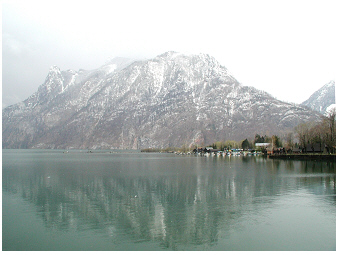 Traunsee, 2001:
Traunsee, 2001:
Der Süden vom großen Traunsee - die „Ebenseer“ Bucht ist im
Verhältnis zur tiefsten Stelle relativ flach. Die Tiefe beträgt hier
nämlich nur etwa 50 m.
The signature that pelagic microorganisms are mainly
inhabiting the top 20 m layer, can also be seen by vertical
profiles of proportion among
the three fractions
of the total phosphorus pool, the annual DRP:DOP:POP
triple ratio (Fig.5A&C
in
Teubner 2003 R). The top
20 m at the deepest site refer to high
portion of
particulate-biotic phosphorus (POP) than compared to the other two
fractions, the dissolved reactive-inorganic (DRP) and the mainly
dissolved organic phosphorus (DOP), respectively (Fig.5A
in
Teubner 2003 R). From 20m to
40 m, the
portion of biotic phosphorus relative two the other two fractions
decrease drastically (see distance of data points refering to the
0-20 m surface layer and the point of 40 m depth Fig.5A
in
Teubner 2003 R).
The biotic fraction is the only fraction of
phosphorus that decreases over magnitudes with depth, while the
proportion between the two dissolved fractions, is more or less uniform
over depth with slight increases toward DRP near the bottom. Further
the
annual mean of the TN:TP:SRSi ratio (Fig.5B&C
in
Teubner 2003 R),
which refers to the stoichiometric
proportions between the
main nutrient elements utilized by photosynthetic
organisms, i.e. nitrogen, phosphorus and silicon, designate the top
20 m
layer as the main phytoplankton layer indicated by a strong
silicon exhaustion relative to
N and P. As described for another lake, phosphorus is a
nutrient element of very short turnover time of about hours to days. As
a rule of the thumb, the turnover for nitrogen takes longer than for
phosphorus, from days to weeks. Both nutrient elements can be recycled
within a season and are hence promptly or fast replenished for algal
utilization. The turnover time needed of silicon is even longer,
usually weeks to months. For that reason, the replenishment of silicon
after exhaustion from near bottom layer is often linked to seasonal
events as mixing in deep (!) lakes. To take account of the rapidly or
in moderate time recycled phosphor and nitrogen, respectively, usually
the total phosphorus pool and also in many cases the total nitrogen
pool is chosen as the resource nutrient pool. In the case of silicon,
the dissolved fraction of soluble reactive silicon is the only
ecologically relevant nutrient source (and not total silicon), as
continuous supply is hampered by long turnover time. The mismatch in replenishment of the three
nutrient elements is also seen by the portions of
dissolved inorganic fractions of each element, DIN:DRP:SRSi (DIN is
dissolved inorganic nitrogen) in Traunsee (Fig.5B&C
in
Teubner 2003 R).
This triple ratio
follows,
in principle, the depth profile of TN:TP:SRSi except for phosphorus as
here the resource nutrient pool (SRP in the lake water) is consistently
underestimated.
Vertical depth distribution was not only found for algae and bacteria but also for planktonic micro-animals in Lake Traunsee. A particular high species richness along depth profiles with seasons was found for ciliate assemblages . More than 50 ciliate taxa could be identified in Traunsee. The most frequent ciliates were Rimostrombidium brachykinetum/Rimostrombidium hyalinum and Balanion planctonicum (list of species in Table 2, scheme of graphical illustration in Fig.5A in Sonntag et al. 2006 R). The seasonal pattern of depth distribution of these aquatic protozoa as ciliates and non-photosynthetic small flagellates (heterotrophic nano-flagellates), was mainly determined by the depth distribution of their potential food sources, e.g. algae and bacteria (Fig.4 in Sonntag et al. 2006 R). A strong increase or decrease of the abundance of ciliates, i.e. of positive or negative net-change of ciliate abundance by growth or loss at a certain time-interval, was necessarily associated with pronounced shifts in species composition. Further, the persistence of ciliate composition, was only found at time-intervals of (almost) zero abundance net-changes. These particular periods refer to an ecological steady state during seasonal development of ciliate assemblages. Such net-change response curves followed a bell-shaped distribution pattern and were not only valid for ciliate assemblages (Fig.2 in Sonntag et al. 2006 R), but also other plankton organisms (see phytoplankton in lake Ammersee S, Fig.7 in Teubner et al. 2003 R).
A multidisciplinary study was carried out to answer questions to what extent the ecology integrity of Lake Traunsee was affected by industrial tailings by salt processing from soda works at the south bay, the ‘Ebenseer Bucht’. The biovolume and chlorophyll-a concentration of the planktonic photosynthetic microorganisms was at the site with the slight phosphorus enrichment, site Ebensee Bay, on average nearly the same when compared with the deepest site (see phytoplankton biovolume in Fig.2A&E in Teubner, 2003 R; see chl-a in Fig.8 in Dokulil & Teubner, 2002 R). According to the phosphorus availability at Ebensee Bucht, we could expect, however, an even higher biomass of plankton organisms. As seen from Fig.5A&D in Teubner (2003 R), about 11 % less phosphorus was bound by planktonic organisms to build up biomass at the impacted site Ebensee Bay when compared with the deepest site (based on annual average during the investigation period from December 1997 to October 1998). This relative (!) low value of microbial biomass in the surface layer at Ebensee Bay could be seen as an inhibition of primary producers due to lowered water transparency. According to in situ measurements of primary production, the phytoplankton at Ebensee Bay represented indeed a phytoplankton community, which was acclimated to low-light conditions (see significant higher values of the maximum light utilization coefficient for phytoplankton at Ebensee Bay than at the deepest site; Tables 1&2 in Teubner & Dokulil, 2002 R). Measurements of the underwater light-climate from April to October 1998 have shown that the euphotic zone (Zeu) was on average 2 m shallower at Ebensee Bay (Zeu = 10.2 m) than at the deepest site (Zeu = 12.2 m, Table1 & Fig.1F in Teubner & Dokulil, 2002 R). This reduced water transparency in the bay was caused by turbidity due to industrial tailings and/or suspended solids inflowing by the River Traun during the investigation period from December 1997 to October 1998. Besides planktic community also benthic organisms, i.e. the organisms that live attached to shore line material as e.g. on the surface of stones, were in detail studied. It could be shown, for example, that the benthic diatom community adjusted to higher salinity nearby the inlet of industrial tailings when compared with other sites studied along the lakeshore of Traunsee (Wunsam et al. 2002 R). The species composition shifted here toward higher abundances of diatoms (e.g. Achnanthes minutissima), which are known to tolerate saline habitats. The indication of the saline environment by benthic diatoms was not well found in all seasons but was most pronounced and statistically significant during late autumn. The long-term development of concentrations of chloride and oxygen at lake surface and bottom layer are displayed for Lake Traunsee in graphs by Jagsch et al. (2002 R), and are discussed in a more detail on the lake Hallstaetter See S website when comparing the both saline lakes. The main outcome of other studies about the ecological integrity of Lake Traunsee in 1997 and 1998 is summarized in a special journal volume in aquatic sciences (Water Air Soil Pollution-Focus 2, 2002 ).
cited References: about traunsee
Dokulil, M. T., Jagsch, A., George, G. D., Anneville, O., Jankowski, T., Wahl, B., Lenhart, B., Blenckner T. & K. Teubner. 2006. Twenty years of spatially coherent deep-water warming in lakes across Europe related to North-Atlantic Oscillation. Limnol Oceanogr, 51 (6): 2787-93. doi:10.4319/lo.2006.51.6.2787 OpenAccess
Sonntag, B., Posch, T., Klammer, S., Teubner, K. & R. Psenner. 2006. Ciliates and flagellates in an oligotrophic deep alpine lake: contrasting variability with seasons and depths. Aquat Microb Ecol, 43: 193-07. doi:10.3354/ame043193 Look-Inside OpenAccess
Teubner, K. 2003. Phytoplankton, pelagic community and nutrients in a deep oligotrophic alpine lake: Ratios as sensitive indicators of the use of P-resources (DRP:DOP:PP and TN:TP:SRSi). Water Res, 37 (7): 1583-92. doi:10.1016/S0043-1354(02)00535-3 Look-Inside FurtherLink
Teubner, K., Tolotti, M., Greisberger, S., Morscheid, H., Dokulil, M.T. & H. Morscheid. 2003. Steady state phytoplankton in a deep pre-alpine lake: Species and pigments of epilimnetic versus metalimetic assemblages. Hydrobiologia 502: 49-64. Look-Inside FurtherLink
Dokulil, M.T. & K. Teubner. 2003. Steady state phytoplankton assemblages during thermal stratification in deep alpine lakes. Do they occur? Hydrobiologia, 502: 65-72. Abstract FurtherLink
Dokulil, M.T. & K. Teubner. 2002. The spatial coherence of alpine lakes. Verhandlungen der Internationalen Vereinigung für Theoretische und Angewandte Limnologie (Verh. Internat. Verein. Limnol.) 28, 1-4. Look-Inside
Teubner, K. & M. Dokulil. 2002. 14C-Photosynthesis of phytoplankton in an oligotrophic alpine lake (Traunsee, Austria) and its response to turbidity caused by industrial tailings. Water Air Soil Poll, Focus 2: 181-190. Look-Inside FurtherLink
Dokulil, M.T. & K. Teubner. 2002. Assessment of ecological integrity from environmental variables in an impacted oligotrophic alpine lake: Whole lake approach using 3D-spatial heterogeneity. Water Air Soil Poll, Focus , 2: 165-80. Look-Inside FurtherLink
Jagsch, A., Gassner, H. & M.T. Dokulil. 2002. Long-term changes in environmental variables of Traunsee, an oligotrophic Austrian lake impacted by salt industry, and two reference sites, Hallstättersee and Attersee. Water Air Soil Poll, Focus , 2: 9-20. FurtherLink
Wunsam, S., Kamenik, C. & R. Schmidt. 2002. Epilithic diatoms in an alpine lake (Traunsee, Austria) affected by soda and salt mining industries. Water Air Soil Poll, Focus , 2: 93-108. FurtherLink
Teubner, K., Sarobe, A., Vadrucci, M.R. & M. Dokulil. 2001. 14C photosynthesis and pigment pattern of phytoplankton as size related adaptation strategies in alpine lakes. Aquat Sci 63: 310-25. doi:10.1007/PL00001357 Look-Inside FurtherLink
